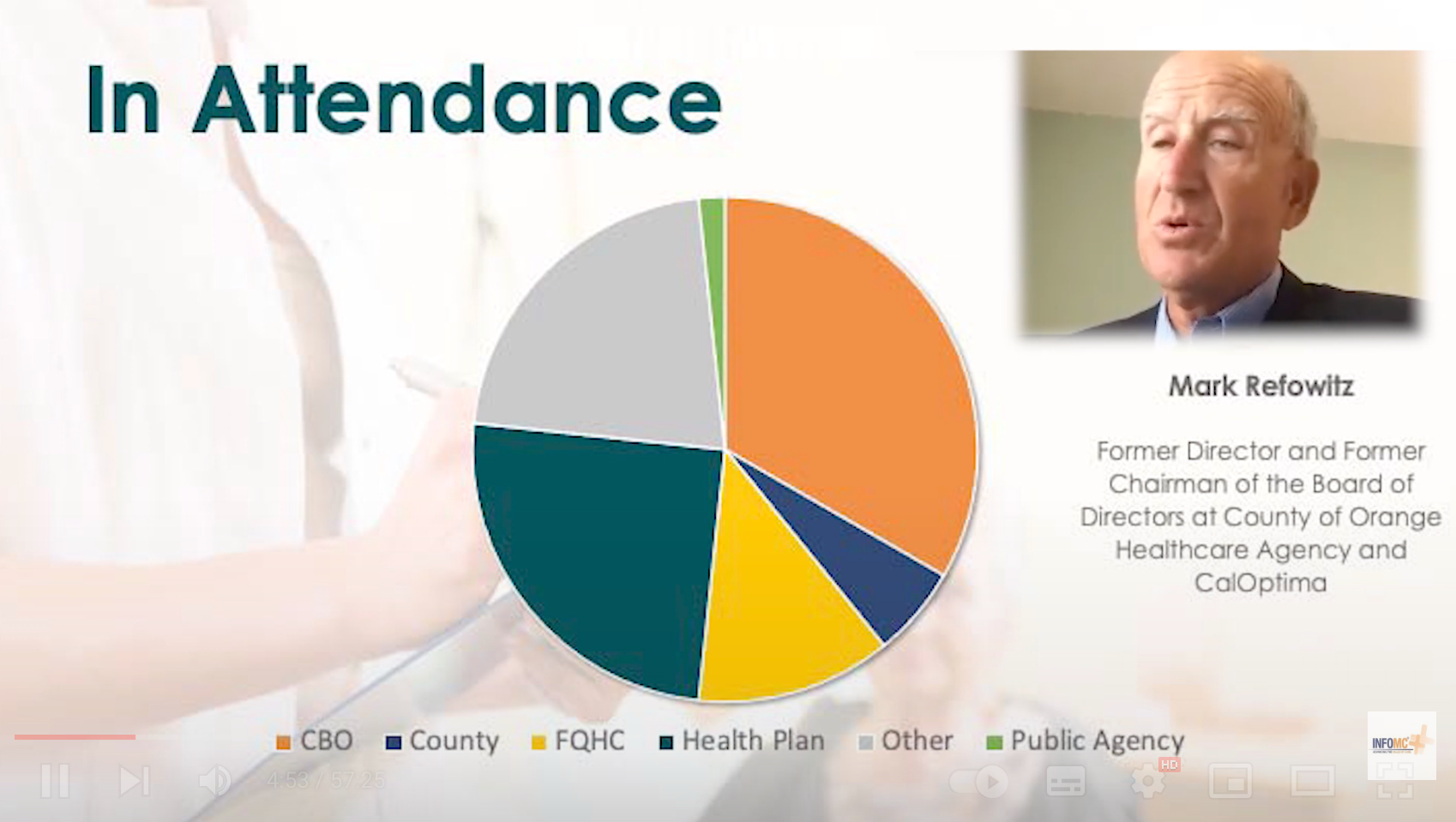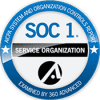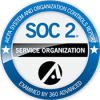CalAIM Six Month Check-Up
CalAIM Six Month Check-Up – Successes and Challenges of Enhanced Care Management and Community Supports Implementation.
A Moderated Discussion Among Health Plan and CBO Leaders from Health Plan of San Mateo and Pacific Clinics.
As we are nearly six months into the launch of the CalAIM initiative, hear perspectives from health plan and CBO leaders on successes and challenges of their ECM and CS implementations. This panel discussion focuses on:
- Lessons learned around preparation, capacity planning, building new capabilities, and the go-live and operational impacts resulting from implementations.

- Insights on moving forward, including how CBO’s can best prepare for their roles in performing new functions such as revenue cycle management, encounter reporting, and what additional capabilities are yet to be built.
- Ideas for innovation beyond the initial implementation based on a proven framework for guiding effective implementation of evidence-based programs and other innovations in human service settings.
- Moderated by: Mark Refowitz – Former Director, County of Orange Health Care Agency and Former Chairman of the Board of Directors, CalOptima.
- Guest Speaker: Eleanor Castillo-Sumi, PhD, BCBA-D, Pacific Clinics, Senior Vice President, Strategy, Innovation and Growth
- Guest Speaker: Chris Esquerra, MD, Health Plan of San Mateo, Chief Medical Officer.
CalAIM Webinar Q&A
Q : Thank you for bringing the topic of implementation sciences and the drivers involved in each phase. This field seems to be the most neglected, yet I would argue foundational to implementing anything as transformational as CalAIM. Aspirational at DHCS but operational at ground zero which is at clinic levels has at least two broad categories that we need to think through. 1) Are they ready and if not, how can we make them be ready? Pt 2) Are they capable? If not, how can we help them become capable?
- CHRIS ESGUERRA, Ph.D.: It appears DHCS will be bringing on a partner to provide technical assistance/support to CBOs to be able to participate in CalAIM activities with health plans. Of course, this is too late. At least it will be present. It is not clear the type of technical assistance or level of support. I do know that a small number of plans (Health Plan of San Mateo being one) are considering providing their own support/technical assistance to CBOs. Advocacy to DHCS on a broader support framework is necessary.
- ELEANOR CASTILLO-SUMI, Ph.D. BCBA-D: I would agree that clinics need a readiness assessment. I think there are 2 layers to address: 1) within the organization; and 2) state-level. Re #1 – While each health plan does some kind of “assessment” in my experience, it does not address the cultural change, understanding of payment structure, etc. that are critical for operations to transition from a primarily county-MHP infrastructure to include a health plan-business infrastructure. I would encourage CBOs or clinics to supplement the ones provided by the health plan. Secondly, there are a number of webinars conducted by DHCS and health plans. I recommend they engage in these webinars and provide feedback in these forums on what providers need to be successful in this system transformation.
Q: It seems that payment coverage of some services through ECM is not going to be as flexible as previous coverage through WPC. One example is programs that engage people with substance use disorders when they are not quite ready to commit to treatment, such as San Mateo’s highly successful Integrated Medication Assisted Treatment program. What prospects do you foresee for such programs to obtain coverage through ECM?
- CHRIS ESGUERRA, Ph.D.: ECM does have a relatively broad definition in terms of engagement work. However, as Eleanor pointed out during the webinar, there are some crucial activities that don’t fall into the definition of ECM. Given that CalAIM is wholly different from WPC (and, inside politics, CMS was not particularly thrilled about California’s version of WPC), there is no current regulatory wiggle room. However, each individual managed care plan can consider funding such efforts outside the CalAIM framework. CBOs can engage in this discussion. However, the managed care plan is not incentivized to fund this type of work as it would be considered “administrative cost,” albeit clinically necessary. As such, ongoing advocacy for upstream efforts that included engagement, broadening ECM definitions, etc. will be a path forward.
- ELEANOR CASTILLO-SUMI, Ph.D. BCBA-D: Currently, ECM will cover individuals who meet criteria (e.g., population of focus, history of hospitalization, chronic medical conditions, etc.), but there are many individuals that do/will not meet the criteria so ECM will not necessarily help them. If people do meet the criteria, the individual might be assigned to another ECM provider so you would need to work with the individual and health plan to make changes if that is appropriate. Operational infrastructure/process would need to be able to track all of this.
Q: What is working in terms of outreach and getting individuals from the W. P. C. Pilot engaged with the service providers? What is resonating with the clients that are? And are the strategies varying community by community?
- ELEANOR CASTILLO-SUMI, Ph.D. BCBA-D: Mark brought up the point of hope and I think that’s a critical thing. When you get that first contact with people whether it’s by phone or going to their homes or meeting them somewhere where they feel safe in the community. Inspiring hope with that first visit is critical. That’s something that’s universal between communities, or across counties/across communities. But there are different strategies. It’s not just with ethnic groups, but also age and rural versus suburban. But working with people who really understand those communities and having them as part of our team is important. That’s a selection piece when you think about an implementation driver and have the competency that you need. The selection of your staff is critical.
- CHRIS ESGUERRA, Ph.D.: Where the plans really help is assigning those members to the CBOs for enhanced case management services. We have the analytics tools to be able to say hey here are the characteristics of those members that we’re sending over to you. To help you plan for this and be able to think about your staffing patterns. We have that data from a demographic perspective from the utilization of services or lack of perspective. I think then, or even internally, where have we tried to reach out from a case management perspective? Have we been successful? Have we not been successful? What has worked before? And so those are things that we readily can provide to varying degrees and I think that’s the key of how then we think about that. Standardizing it from a statewide perspective because from a planning perspective this is our population health management effort, how we think about our membership overall, and that we’re already working to stratify our population in some way or another. We have that information. That’s where we can become partners to then help and really fuel that creativity by way of the data.
- ELEANOR CASTILLO-SUMI, Ph.D. BCBA-D: That would be amazing from the CBO perspective. We would love to have that data. From the CBO perspective, we know our experience has been that in the last two years we can convert from 25 to 40% of members. There are some differences between health plans with our experiences and then about 25% of the data. The information that we get, accounting for wrong numbers, numbers that don’t work, that’s about 25 that’s consistent, about 25% of our data. We know that we must work hard to get the right information, but for us, we’re more interested in not only who converts but who doesn’t and why. Is there a certain profile? Because then we can strategize more specifically to reach out to those people. We hope that we can get there at some point and that’s part of again the data infrastructure that providers need to develop.
- CHRIS ESGUERRA, Ph.D.: I was with a different plan when we implemented the Help Homes program, and the state the HCS was targeting an initial engagement of a pretty high rate. It was in the double digits definitely, and when you looked at other states that had implemented health homes, the first-year engagement rate was pretty much if not one percent, then low single digits. The reality is that this was just new, and people had to be creative. People had to then figure out the data component, and what was needed. Now, what was interesting in part of the rolling out was the financial model that we decided to take that kind of gets to Eleanor’s point of financing the creativity. So typically, the payment model for Health Homes was once you have someone enrolled, you get paid. We actually chose a different route. Saying, okay sure, we’ll pay that, we’ll take some of that though, and for the entire list that we’re going to give you, we’re going to give you what essentially is called the engagement fee. Because we know you’re going to do a lot of work for free and so we’re going to need to fund that. And that got people to be much more creative, but it’s again being mindful of the payment model itself and what exactly is being paid versus what isn’t. I think it’s helpful however, from the planned perspective, we won’t necessarily know that unless we get feedback and it gets back to what Eleanor is saying is how do we build that feedback mechanism so, and to have those discussions to be able to acknowledge the work.
Q: Given that Pacific Clinics is in multiple counties, are you finding that the implementation experience differs from one county to the next?
- ELEANOR CASTILLO-SUMI, Ph.D. BCBA-D: Absolutely. The relationship between health plans and counties varies right across the state. There are counties that did the whole person care did H. H. P. and so those counties tend to be a little bit more advanced, if you will, with implementation. There are counties that didn’t and are still trying to figure this out and the providers are at the end of the county trying to figure this out. And when I say, the county, it’s the relationship between the health plan and a county.
Q: Based on populations of interest, how should the implementation be thought of for future rollouts? For example, what should it look like for the incarcerated population who are returning to the community?
- CHRIS ESGUERRA, Ph.D.: There’s pre-work that has to be done. You can’t just say, all right, we’re going to go live, and magically we’re live. Part of the pre-work is understanding these populations of focus. You heard me on my little rant of like here are the things we need to pay attention to for those who are criminal justice involved. But that’s the same thing for every other population of focus. You know, when we’re talking about foster youth, the same thing. There’s a whole different system of care or supports that we need to then be thinking about. I think that pre-work to then start thinking well, who else is involved? How do we get them involved? And how do we think about the design of this? Great goals to start really thinking about these populations that are very challenging. We need to understand though, that there is a system that already exists that in some way or another supports, somewhat supports/may not support that population. How is it that we start engaging sooner rather than later? Because it might be something as basic as when I say case management, that might mean different things to staff in Eleanor’s clinics, versus when I say it to my teams, versus when I say it to probation, versus when I say it to a housing coordinator. Even in the way we use terms and learn each other’s languages I think is part of the pre-work.
- ELEANOR CASTILLO-SUMI, Ph.D. BCBA-D: Absolutely. It goes back to implementation science. I mean, that’s program installation and having adequate time for that and having this forum where CBOs are a part of it. I cannot underscore enough just that the program installation phase that can take months.
Q: How are the CBOs managing payment slash invoicing back to the health plans? And what is the biggest challenge in this process?
- ELEANOR CASTILLO-SUMI, Ph.D. BCBA-D: As an organization that primarily had contracts with county health plans, we built our infrastructure for payments around doing that business. This is a different skill set to build. Health plans are a different skill set. It’s a different process, and we tried to build this on the backs of our staff that built for the services. And we learned this is where again, organizations need to be willing to try something, fail fast, and change. But we quickly learned that this was something we couldn’t build. This is something that we needed to partner with organizations, a third-party biller. Not just have a third-party billing, but really interview that third-party biller to see if they would be partners with us. If they would be the right partner with us. Coming with the payment structure for their services, while there are lots of building organizations out there, it’s finding the right one. And so, we do it. We have a 3rd party biller.




